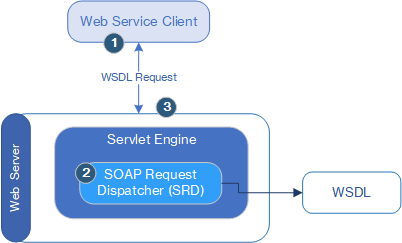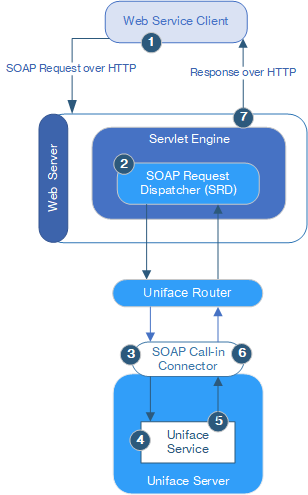SOAP Call-In to Uniface From a Web Service Client
A Uniface service can be deployed as a web service by exporting the service's interface definition into a WSDL file, publishing it on the web site, and deploying the service in the Uniface web service deployment environment. Clients that use the Uniface web service need to send a WSDL request to get the interface definition of this service, and send web service requests to call operations provided in the service.
Web Service Deployment Environment
The Uniface web service deployment environment consists of the following:
- Servlet engine running in a web server—Uniface provides a complete web service deployment environment, using Apache Tomcat as the web server and servlet engine. You can also use other web servers and servlet engines.
- SOAP Request Dispatcher (SRD)—the SRD handles the request for WSDL files directly. It handles the request for web services by activating the appropriate Uniface service component via the Uniface Router, SOAP call-in connector and Uniface Server. For more information, see SOAP Request Dispatcher (SRD).
- Uniface Router—For more information, see Uniface Router .
- Uniface Server—For more information, see Uniface Server.
For more information, see Deploying a Uniface Web Service. Uniface also provides an API that enables you to implement your own enhanced security for web services. For more information, see Web Services Call-In API .
How Web Services Call-in Works
The following illustration shows the components involved in a call-in request for a WSDL:

- A client constructs a request for a WSDL and sends it to the web server.
- The web server redirects the request to the SRD servlet, which retrieves the WSDL file.
- The SRD passes the content of theService.wsdl back to the web server, which passes it back to the client.
The following illustration shows the components involved in a call-in request for a web service.

The following events occur:
- A client constructs a web service request and sends it to the web server, which redirects the request to the SRD servlet.
- The SRD extracts the request and activates the appropriate Uniface service component over the Uniface network.
- The SOAP call-in connector:
- Detects that the request is a SOAP request and unpacks it.
- Maps SOAP data types to Uniface data types.
- Activates the operation defined in the SOAP request with the given parameters.
- The Uniface service component handles the operation.
If this is an asynchronous communication, there is no further activity. For synchronous communication, a response must be passed back, as follows:
- The Uniface service component returns the return data.
- The SOAP call-in connector maps the Uniface data types back to SOAP data types and constructs a response containing the return data, passing it back over the Uniface network to the SRD.
- The SRD receives the response over the Uniface network, extracts the SOAP response, and passes it back to the web server, which passes it back to the client.
